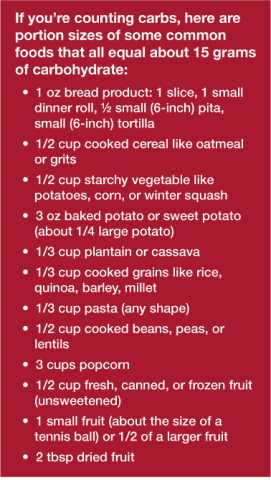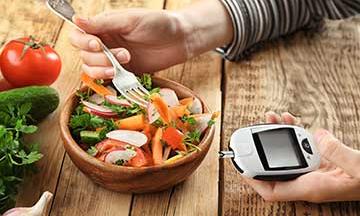Whether you have recently been diagnosed with diabetes or prediabetes, or have been managing it for years, you probably know that what you eat has a big impact on your blood glucose.


Whether you have recently been diagnosed with diabetes or prediabetes, or have been managing it for years, you probably know that what you eat has a big impact on your blood glucose.
Carbohydrates from food cause blood glucose to rise after meals, but that doesn’t mean you have to eliminate carbs from your meals! Carbohydrate foods are also important sources of other nutrients like fiber, vitamins, and minerals, and they provide energy for our body and our brain.
Related: Ask the Experts: All About Carbs
There’s no set number of carbs that everyone with diabetes should eat. The eating plan and carb amount that works for you will depend on your gender, activity level, and blood glucose management plan, among other things. It will also depend on your current eating habits, food preferences, and budget.
Depending on your current eating habits, making some adjustments to your carb intake may help with blood glucose management. But, there’s no need to make drastic changes to your diet all at once, and you don’t have to eat foods you don’t like!
We encourage you to work with a Registered Dietitian (RD/RDN) or Diabetes Care and Education Specialist (CDE/CDCES) to determine what amount of carbs is right for you, and come up with a meal plan that meets your unique needs.
Whether you want to reduce your carb intake or not, doing one or more of these tips can help you manage your blood glucose:
Related: Carb-Conscious Meal Makeovers
If you do want to lower your carb intake, these tips are easy ways to cut back, without sacrificing your favorite foods:
REDUCE
Reduce the portion size of carb foods in your meal. Cutting back on the amount of rice, pasta, or other carb foods in your meal is an easy way to reduce carbs without giving anything up.

The Diabetes Plate Method is a great visual way to manage portion sizes, without any counting or measuring. Simply limit your portion of carb foods to about one-quarter of your plate.
REMOVE
If a meal includes several carbohydrate foods, remove one. For example, a burrito may include rice, beans, and a tortilla. Leaving out the rice won’t impact the flavor, but it will cut down on the carbs. Or, you could ditch the tortilla and make a “burrito bowl.”
REPLACE
If you’ve reduced or removed carb foods from your meal, you can replace them with lower carb alternatives.
For example: